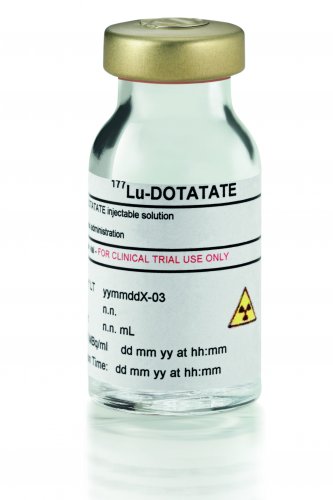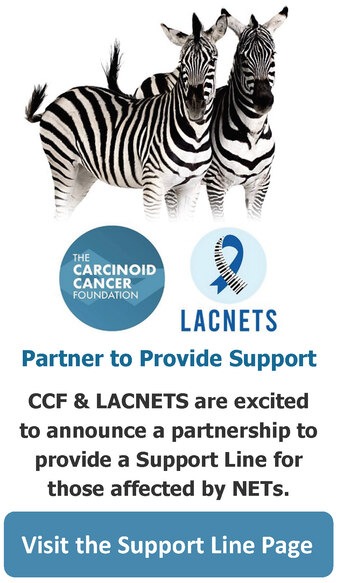The clock is ticking!! With Advanced Accelerator Applications’ completed New Drug Application (NDA) submission of Lutathera to the U.S. Food and Drug Administration last week, a decision from the FDA is expected by early 2017. Additionally, an Expanded Access Program (EAP) in the United States for the investigational product, Lutathera, is expected to begin in about 2 months at 2-5 institutions. Through the Expanded Access Program Lutathera is being made available to patients with “inoperable, somatostatin receptor positive,  midgut carcinoid tumors, progressive under somatostatin analogue therapy.” Read more at www.clinicaltrials.gov (trial number NCT02705313) or click here: https://clinicaltrials.gov/ct2/results?term=NCT02705313&Search=Search .
midgut carcinoid tumors, progressive under somatostatin analogue therapy.” Read more at www.clinicaltrials.gov (trial number NCT02705313) or click here: https://clinicaltrials.gov/ct2/results?term=NCT02705313&Search=Search .
More about the Expanded Access Program for PRRT:
What is Expanded Access?
Expanded access, sometimes called “compassionate use,” is the use outside of a clinical trial of an investigational medical product (i.e., one that has not been approved by FDA).
Which institutions are participating in the Lutathera EAP?
The first institution to participate in the EAP is Montefiore Medical Center in the Bronx (borough of New York City), New York. The contact person is Dr. Edward Wolin. Additional institutions anticipated to participate initially are University of California Los Angeles; the NIH (National Institutes of Health) in Bethesda, Maryland; and the University of California San Francisco. Approximately 22 additional institutions have expressed interest in being a site for the Lutathera EAP. As new sites are approved, they will be listed on the clinicaltrials.gov website above.
When will the Lutathera EAP begin?
The targeted date for the start of this program is mid-summer 2016 depending upon a number of factors. See below
What’s involved in being designated as a site for the Lutathera EAP?
This is an extremely complex process which has to be coordinated with a number of departments at an institution. First, the EAP must receive IRB, or institutional review board, approval. The institution must also have an updated radioactive license to handle the administration of Lutathera (or 177Lu-DOTATATE). The process to get this license varies from state to state. Additionally, there must be coordination with several departments at an institution including billing.
Will insurance cover the EAP therapy?
For all participating in the Lutathera EAP, Advanced Accelerator Applications will cover the cost of the Lutathera product during the maximum 4 cycles of treatment. However, the procedure of administering Lutathera includes amino acids for kidney protection and antiemetics to prevent nausea and vomiting. These must be prescribed by the physician in charge of the EAP as a “standard of care.” They may be paid for by one’s insurance but it is also possible a patient may be billed for this. All costs should be discussed by the patient with the participating institution and if applicable, with your insurance company.
What happens if I enroll in the EAP therapy and the FDA approves Lutathera?
Any patient enrolled in the EAP therapy will receive Lutathera treatments free of charge (see above regarding costs covered) even if the FDA approves Lutathera during the time they are enrolled in the EAP. However, if an institution changes its policies if Lutathera is approved by the FDA, there may be some changes regarding possible additional charges to participants.
The Carcinoid Cancer Foundation will continue to provide updates about Lutathera as they become available. We remain optimistic that this will become an FDA-approved therapy for neuroendocrine cancer patients!!
For more information about PRRT, see below.
What is Peptide Receptor Radionuclide Therapy or PRRT?
Here’s more information from the Society of Nuclear Medicine and Molecular Imaging: http://www.snmmi.org/AboutSNMMI/Content.aspx?ItemNumber=5691
Topics Covered:
- What is peptide receptor radionuclide therapy (PRRT) and how does it work?
- What conditions are treated with PRRT?
- How is PRRT performed?
- What are the advantages of PRRT?
- Is PRRT safe?
- Side effects
- Home care
- Is PRRT covered by insurance?
- What’s new in PRRT research and development?
What is the NETTER-1 Clinical Study?
Begun in July of 2012, the NE TTER-1 clinical trial is the first Phase 3 international, multicenter randomized clinical trial in patients with inoperable progressive midgut neuroendocrine tumors (NETs). The NETTER-1 study evaluated the efficacy and safety of Lutathera® (or 177Lu-DOTATATE) compared to high dose Octreotide LAR in patients with inoperable, progressive, somatostatin receptor positive, midgut carcinoid tumors. The primary objective of the trial is the assessment of Progression-Free Survival (PFS). Secondary objectives include objective response rate, overall survival, safety, and health-related quality of life.
Results: According to carcinoid/NET specialist Dr. Jonathan Strosberg, “The findings were, in my opinion, extraordinarily impressive, the median progression-free survival improved by nearly 80%, which is fairly unprecedented in oncologic studies. The finding is important because limited therapeutic options exist for such patients, who comprise 20% to 45% of neuroendocrine tumor cases.” Study results were presented by NET specialist Dr. Philippe Ruszniewski for the first time at the European Cancer Congress during the Presidential Session on September 27, 2015 and for the first time in North America by Dr. Strosberg at NANETS in November 2015.
http://https://www.youtube.com/watch?v=JqIQJlwDjJY
http://https://www.youtube.com/watch?v=fxFf3e-kZyM
PRRT and Neuroendocrine Tumors:
Learn more about peptide receptor radionuclide therapy (PRRT) in this newly released OncLive video. NET specialist Dr. Eric H. Liu describes the therapy, how to determine if patients have somatostatin receptors needed for PRRT, and talks about the findings of Advanced Accelerator Applications’ NETTER-1 clinical trial. Watch the video below.
http://https://www.youtube.com/watch?v=Ip5mJA9ZKG0


